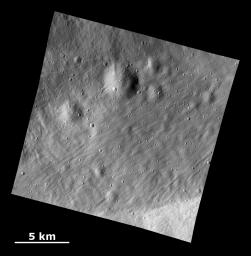Smooth Ejecta with Grooved Surface Showing Buried Craters
Caption:
This Dawn Framing Camera (FC) image shows a surface with craters buried under thick ejected material that displays a grooved texture on the giant asteroid Vesta.
The image covers an area in the equatorial cratered terrain, centered around 18.9 degrees south latitude and 253.3 degrees east longitude. NASA's Dawn spacecraft obtained this image with its framing camera on Dec. 18, 2011. The distance to the surface of Vesta is 201 kilometers and the image has a resolution of about 25 meters per pixel. This image was acquired during the LAMO (Low Altitude Mapping Orbit) phase of the mission.
Background Info:
The Dawn mission to Vesta and Ceres is managed by NASA's Jet Propulsion Laboratory, a division of the California Institute of Technology in Pasadena, for NASA's Science Mission Directorate, Washington. UCLA is responsible for overall Dawn mission science. The Dawn framing cameras have been developed and built under the leadership of the Max Planck Institute for Solar System Research, Katlenburg-Lindau, Germany, with significant contributions by DLR German Aerospace Center, Institute of Planetary Research, Berlin, and in coordination with the Institute of Computer and Communication Network Engineering, Braunschweig. The framing camera project is funded by the Max Planck Society, DLR, and NASA/JPL.
More information about the Dawn mission is online at
http://www.nasa.gov/dawn
and
http://dawn.jpl.nasa.gov
.
Cataloging Keywords:
| Name |
Value |
Additional Values |
| Target |
4 Vesta |
|
| System |
Main Belt |
|
| Target Type |
Asteroid |
|
| Mission |
Dawn |
|
| Instrument Host |
Dawn |
|
| Host Type |
Orbiter |
|
| Instrument |
Framing Camera (FC) |
|
| Detector |
|
|
| Extra Keywords |
Crater, Grayscale |
| Acquisition Date |
|
| Release Date |
2012-01-13 |
| Date in Caption |
2011-12-18 |
|
| Image Credit |
NASA/JPL-Caltech/UCLA/MPS/DLR/IDA |
| Source |
photojournal.jpl.nasa.gov/catalog/PIA15298 |
| Identifier |
PIA15298 |

 Planetary Data System
Planetary Data System
